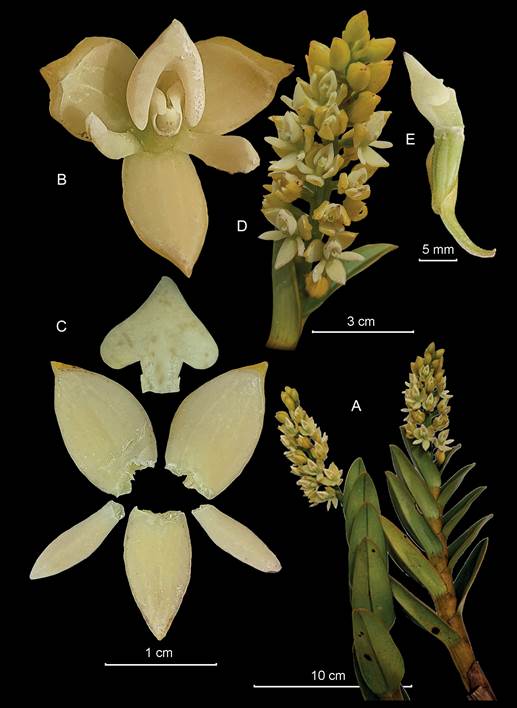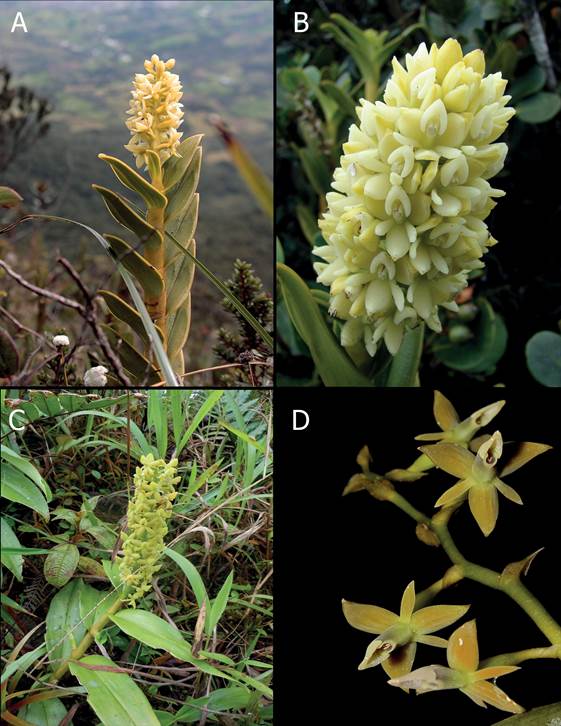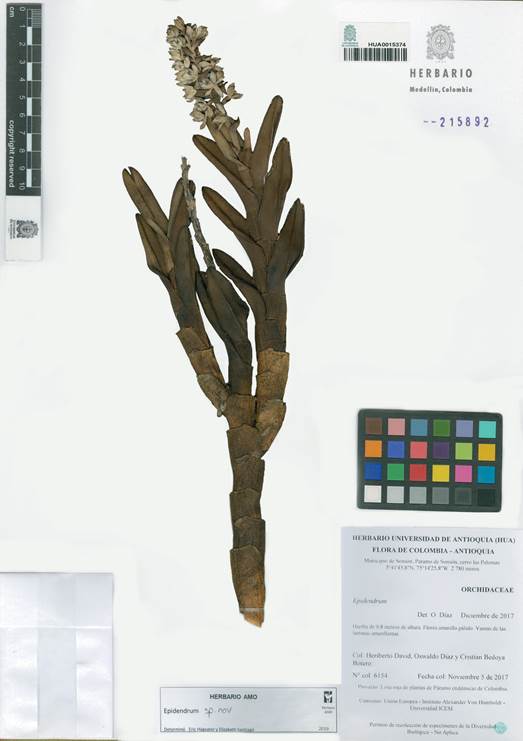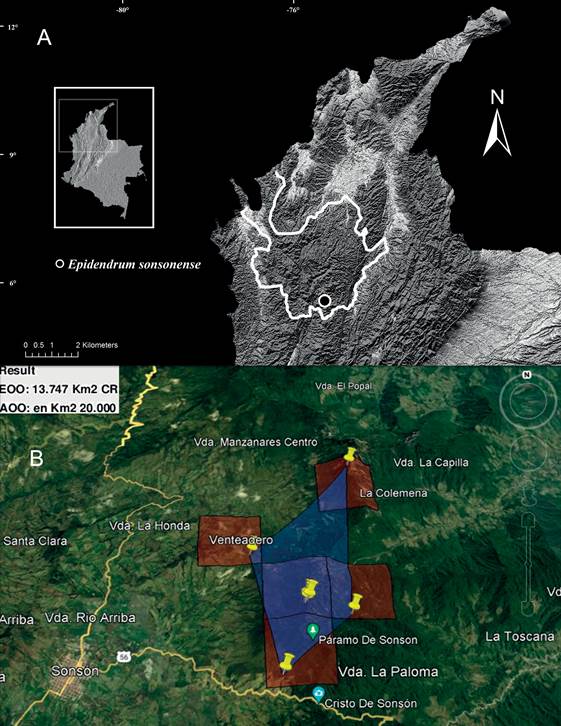Introduction
Preserved historical collections have been a source of information for the biodiversity on our planet. Herbaria are the reservoir of the biological diversity of a region, country, or geographical space (Martínez & Domínguez 2017) and represent the natural patrimony of a country or region in addition of constituting a natural history archive for multiple uses (Álvarez et al. 2002). Furthermore, preserved herbarium collections, as a primary source of knowledge and information, constitute a warehouse of the richness, variability, and vegetal abundance through the compilation of dried plants correctly preserved in a well-organized manner (Cascante-Marín 2008).
Historically, the Orchidaceae has been widely collected and studied worldwide. However, there has always been a great difficulty in studying these plants in herbarium collections, especially small and miniature neotropical orchids such as Lepanthes Sw. (Swartz 1799), Platystele Schltr. (Schlechter 1910), Pleurothallis R.Br. (Brown 1813), and Stelis Sw. (Swartz 1800), because the floral structures often lose their shape and coloration after drying, a detailed inspection by the taxonomist is required to prepare adequate descriptive work for the preparation of a botanical illustration.
The genus Epidendrum L. (Linnaeus 1763) is considered one of the largest and most diverse in the Orchidaceae family; nevertheless, the diversity of the genus has been misjudged by the lack of representative specimen in herbaria and living collections and an overestimation of the natural variation of taxa (Karremans 2021). Epidendrum is distributed from South Carolina, in the United States to the south in Argentina (Hágsater & Soto Arenas 2005), and has an impressive vegetative and floral variability. The genus belongs to the Laeliinae subtribe; and it is distinguished by having the following combination of characters: the column is united to the labellum (in most species), the anther is dorsal, the rostellum is parallel to the axis of the column and slit after the removal of viscarium which is semi-liquid, the lateral lobes of the stigma are well-developed, and it has a cuniculate nectary (Dressler 1984). The genus includes approximately 2400 species (Hágsater et al. 2016), of which 1100 have been described in the past 40 years. Epidendrum is so broad that it has been necessary to separate it into informal groups to understand it better; 90 informal groups are currently in use (IOSPE 2021), but that number will undoubtedly change with further study and the addition of molecular information, probably reducing the number of groups and recognizing more sub-groups.
The Macrostachyum group is characterized by its plants, usually erect, monopodial canes, with subapical ramifications, inflorescences generally in racemes, erect, flowers with the perianth of uniform color, fleshy, with an entire labellum, strongly concave, more or less pubescent at the base (Hágsater et al. 2016). Ecologically, many of the species of this group are endemic and have restricted distributions to a geographic region in the high Andean forests and paramos, with major diversity in the north of South America in Colombia, Ecuador, Peru, and Venezuela.
The different species included in this group can be easily recognized by the shape and size of the leaves, the thickness of the stems, the length of the floral bracts compared to the ovaries, the color, size and number of flowers, ornamentation of the tepals and the type of inflorescence. In herbarium specimens, these same features can be seen, but rehydration of a flower is necessary to observe the presence or absence of ornamentation on the tepals, as a superficial observation of dried material can confuse similar species.
In this paper, we describe and illustrate with a Lankester Composite Digital Plate (LCDP) a new species of Epidendrum belonging to the Macrostachyum group. The first specimen of this species was collected in the Sonsón Paramo in 1989, and more collections from the same paramo were found until 2020, remaining hidden and without a clear identity for 33 years in the collections studied.
Materials and methods
During recent revisions in 2017, 2018, 2019, and 2020, we examined the specimens deposited in the Colombian herbaria JAUM (where the first specimens of the species described here were found) CAUP, COL, FMB, HUA, JBB, PSO, MEDEL, and TOLI. Some flowers were rehydrated and dissected to study each of the floral segments, also dissecting the column and the ovary to analyze the internal details of the cuniculus and the stigmatic cavity. Photographs with scale were taken for study and description. The information derived from the revision of the specimens was verified at the AMO-DATA base (2021) and was searched for possible duplicates or other unidentified specimens of the Macrostachyum group from the same general geographic area. A LCDP was prepared from the photographic material available and a botanical description. The new species was compared with the most similar species in the Macrostachyum group. The Geospatial Conservation Assessment Tool (GeoCAT) application (http://geocat.kew.org/) was used to establish the conservation status.
Taxonomic treatment
Epidendrum sonsonense Rinc.-González, E.Santiago & Hágsater, sp. nov.Fig. 1, 2A-B.
TYPE: COLOMBIA. Antioquia: Municipio de Sonsón, Páramo de Sonsón, Cerro las Palomas, 2780 m, 5 noviembre 2017, Heriberto David, Oswaldo Diaz y Cristian Bedoya 6154 (holotype HUA!). Fig. 3.
Diagnosis: Epidendrum sonsonense is recognized by its robust, branched plants, with thickened stems up to 2.3 cm in diameter, leaves 2.7-10 × 1.4-3.0 cm, ovate-elliptic, suberect and very rigid, slightly imbricate and inflorescences 6.0-9.5 cm long, pluriflorous and dense, completely hiding the peduncle, small flowers (sepals 7-12 mm long) of creamy yellow color and cordate labellum.
Terrestrial, monopodial, branched, erect herb, 50 to 180 cm tall. Roots 1.5-3.0 mm in diameter, basal from primary and secondary stems. Stems cane-like, terete, erect, straight, very robust, branching when mature, branches sub-apical and erect, base covered by sheaths 2.8 cm long, tubular, non-foliar, scarious; primary stem 44-120 × 2.0-2.3 cm; secondary stems 10-30 × 1.0-1.5 cm. Leaves 14-18 from primary stem, 7-14 on the branches, distributed throughout stems, articulate to foliar sheath, sub-erect with respect to stem when mature, slightly conduplicate along basal half, nearly imbricated, similar in shape, two apical leaves decreasing in size, coriaceous, very rigid; sheaths 1.5-3.5 cm long, tubular, striated, rugose, pale yellow to creamy yellow; blade 2.7-10.0 × 1.4-3.0 cm, ovate-elliptic, green concolor when alive with ventral surface glaucous and margin ochre-green, when dry the leaf surface is ochre and the underside brown, entire, slightly revolute, apex obtuse. Inflorescence 6.0-9.5 cm long, apical, developing from mature stems, racemose, erect, compact, dense; peduncle 9-13 × 3.8-5.0 mm, terete, straight; rachis 45-75 mm long, straight, pale green. Floral bracts 5-11 × 3.5 mm, as long as ovary or slightly longer than ovary, triangular, apex acuminate, margin entire, embracing. Flowers 20-35, successive, basal flowers opening first, non-resupinate, distributed along the rachis, pale yellow to creamy yellow, column pale green to pale purple in the apex, fleshy; fragrance sweet, faint. Ovary 7-11 mm long, terete, thick, furrowed, yellow-green. Sepals free, partly spreading, fleshy, apex obtuse, 3-veined, with a dorsal keel, margin entire, spreading; dorsal sepal 7-11 × 3.5-6.0 mm, narrowly ovate; lateral sepals 7.5-12.0 × 4-8 mm, ovate-elliptic, oblique. Petals 6.5-10.0 × 1.5-3.0 mm, partly spreading, free, oblong-oblanceolate, oblique, apex obtuse, 1-veined, margin entire. Labellum 4.5-8.0 × 4-8 mm, united to the column, fleshy, entire, cordiform, base cordate, apex obtuse, embracing column in natural position without covering it; disc with two small oblong keels at the base. Column 4.5-7.0 mm long, thick, terete, with a pair of apical narrowly rounded wings at the apex. Clinandrium reduced, margin entire. Anther 4-celled, ovoid, white. Rostellum apical, slit. Nectary shallow, without penetrating ovary, without ornamentation detail. Capsule not seen.

A. Plant habit.
B. Flower.
C. Dissected perianth.
D. Inflorescence.
E. Ovary, column, and lip.
Photographs by Juan José Vergara (Corporación Parque Arví), based on Deisy Vásquez 001 (JAUM), extended lip based on Betancur 5864 (FMB). LCDP elaborated by Sebastián Moreno and Anaís Cisneros.
Figure 1 Epidendrum sonsonense Rinc.-González, E.Santiago & Hágsater.

A. Plant habit.
B. Inflorescence.
C. Epidendrum polyanthostachyum.
D. Epidendrum lasiostachyum.
Photos by David Sánchez (A), Jorge M. Vélez (B), Duván A. García R. (C), and Lizeth RodríguezMartínez (D).
Figure 2 Epidendrum sonsonense.

Reproduced with the permission of MEDEL herbarium.
Figure 3 Type of Epidendrum sonsonense Rinc.-González, E.Santiago & Hágsater.
Other specimens examined: COLOMBIA. Antioquia: Municipio de Sonsón: Páramo de Sonsón: Cerro de Las Palomas, 3370 m, 16 X 2009, Alzate et. al. 3379, HUA! Páramo de Sonsón, 2700-3240 m, 10 I 1995, Betancur et al. 5864, FMB! (LCDP, pro-parte (only dissected flower), HUA! Vereda Norí, Cerro de las Papas, vertientes hacia el Magdalena, 2960 m, 20 X 1997, Cogollo et al. 11436, JAUM! Cerro de Las Palomas, alrededores de la escalera para subir a la cima del cerro, 3250 m, 16 VI 2012, Díaz et al. 828, HUA! Páramo de las Palomas. 3290 m, 11 VII 1989, Hoyos et al. 1197, HUA! Páramo Alto de las Palomas, 3400 m, 13-16 XI 2008, Méndez 4571, HUA! Páramo de las Palomas, 3366 m, 10 IV 2014, Sarrazola et al. 507, HUA! Páramo La Vieja, 3112 m, 15 V 2014, Sarrazola et al. 616, HUA! Vereda Manzanares bajo, Morro de La Vieja, 3160 m, 11 XI 2020, Vásquez et al. 001, JAUM! (LCDP voucher, (pro parte) Fig. 2). Vereda San Francisco, la Palmita, Cerro La Paloma, 3350 m, 8 IV 2009, Vélez-Puerta et al. 3297, MEDEL! (digital images of live material, AMO! MEDEL!)
Other records: COLOMBIA. Antioquia: Municipio de Sonsón, Venteadero, 2625 m, 3 IV 2020, Carmona s.n., digital image: https://www.inaturalist.org/observations/43244852.Vda. La Francia, 1850 m, 22 VI 2018, Salazar s.n., digital image: https://www.inaturalist.org/observations/13915103. Páramo de Sonsón, 3200 m, 22 VI 2018, Sánchez s.n., digital image: https://www.inaturalist.org/observations/13824318.
Recognition: Epidendrum sonsonense belongs to the Macrostachyum group (Santiago & Hágsater 2013), which is characterized by monopodial plants with sub-apical branching, rugose leaf sheaths, large leaves generally spreading, the erect racemose inflorescence, and the fleshy flowers generally green to black (ripe olive colored), as well as yellow to pink to purple, the entire, conduplicate, generally ecallose lip embracing the column, and the nectary pubescent to papillose in front of the stigmatic cavity and at least at the base of the lip. The new species is recognized by the robust stems, 2.0-2.3 cm thick, the leaves 2.7-10 × 1.4-3.0 cm, sub-erect, coriaceous, very rigid, somewhat imbricated, the inflorescence dense with successive flowers yellow to creamy yellow, the floral segments partly spreading, very fleshy, the sepals 7-12 mm long and the labellum cordiform. It is similar to Epidendrum polyanthostachyum Hágsater, E.Santiago & García-Ram. (Hágsater et al. 2013) (Fig. 2C), ranging from the departments of Valle del Cauca and Chocó, Colombia, but that species has thin stems, 0.5-1.0 cm thick, the leaves spreading, larger and sub-coriaceous, the inflorescence dense with simultaneous flowers green turning yellow upon ageing, the floral segments spreading and the labellum widely deltoidal. Epidendrum lasiostachyum Rodr.Martínez, Hágsater & E.Santiago (Hágsater et al. 2016, Santiago & Hágsater 2018) (Fig. 2D), endemic to the Valle del Cauca, Colombia, is florally similar but the plants are smaller with thin stems, 0.3-0.5 cm thick, the leaves are 4.5-6.0 × 0.8-1.0 cm, lanceolate and spreading, the inflorescence is laxly few-flowered, the flowers yellow with the apex of the column purple, and the labellum is trullate, thickly covered by trichomes.
Etymology
In reference to the municipality of Sonsón, Paramo de Sonsón, Antioquia, Colombia, where the new species has been found.
Habitat and ecology
he species is known only from the Municipality of Sonsón, Paramo de Sonsón, Cerro de las Palomas, Cerro de las Papas, and Paramo La Vieja (Fig. 4A). Plants are frequently found at 2940 (2700?)-3400 m in a high Andean disturbed shrub paramo where it grows as a terrestrial with Espeletia Mutis ex Bonpl. (Mutis 1808) (Asteraceae), Guzmania mosquerae Mez (Mez 1896) (Bromeliaceae), and relicts of Weinmannia L. (Linnaeus 1759) (Cunoniaceae). The species is found flowering between April and November, probably blooming all year round.
Conservation status
This species has five known locations with an extent of occurrence (EOO) of 13,747 km2 and an area of occupancy (AOO) of 20,000 km2; these parameters put Epidendrum sonsonense in the Endangered category. However, E sonsonense is found within the area that is part of the Regional District of Integrated Management (DRMI) Páramo de Vida Maitamá-Sonsón, declared by Agreement 388 of 2019 by the Board of CORNARE as a conservation figure, in which the Paramo of Sonsón, Argelia, Nariño, is reserved as a special management area, being an area of special ecological importance necessary for the conservation of the strategic ecosystem paramo of Sonsón (CORNARE 2021). Therefore there is no continuing decline in any of the necessary parameters and cannot be assessed with criterium B, but because the species has a very restricted geographic range limited to this protected paramo complex and climate change conditions could negatively affect its distribution and lead to its extinction, the threat category is proposed as Near Threatened (NT).
Conclusion
A new Colombian species, Epidendrum sonsonense, is described from a very restricted area in the Department of Antioquia, Municipality of Sonsón, where it could be found within the area that is part of the Regional District of Integrated Management (DRMI) Páramo de Vida Maitamá Sonsón, on the hills of Cerro de las Palomas, and Cerro de las Papas. It belongs to the Macrostachyum group and is added to an extensive list of new species identified from herbarium material, a task that may be possible by revising all available herbaria and a detailed search of photographs of live material.












 uBio
uBio 



